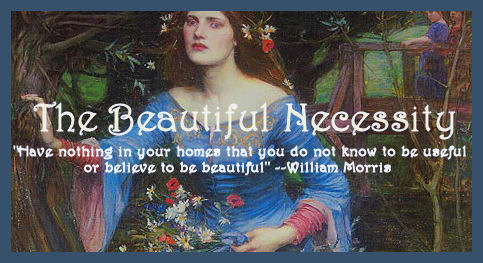
Two years ago, I did
a post on a comment Edward Burne-Jones had made about how he saw the days of the week as different colors, except for Sunday which was "wet, ever since I was tiny, though I don't know why." At the time, an anonymous poster mentioned that there was a term for this condition,
Synesthesia, but I didn't do much follow up on the idea, I'm sorry now to admit. Then, the other day, while perusing a totally unrelated blog that was talking about animating inanimate objects as another symptom of synesthesia, the subject came to my attention again, and I read the
Wikipedia article about the condition.
According to the article, Synesthesia is "a neurologically-based condition in which stimulation of one sensory or cognitive pathway leads to automatic, involuntary experiences in a second sensory or cognitive pathway." Burne-Jones' admission that the days of the week represent different colors is probably an example of grapheme ---> color synesthesia, in which "letters or numbers are perceived as inherently colored."

Also according to the article, "Although synesthesia was the topic of intensive scientific investigation in the late 1800s and early 1900s, it was largely abandoned by scientific research in the mid-20th century, and has only recently been rediscovered by modern research." If the condition was discussed in the late 1800s, it makes me wonder if Burne-Jones was aware of it. I would love to find out how people with synesthesia were regarded in the late Victorian era. Was it considered just a quirk, or was it a symptom of a more serious mental condition to them?
Quite a few synesthetes end up in artistic careers. "Many people with synesthesia use their experiences to aid in their creative process, and many non-synesthetes have attempted to create works of art that may capture what it is like to experience synesthesia." Or, as another wonderful article on the topic states, "There are elements of synethesia in almost any creative endeavor. It is no wonder that so many artists were self-proclaimed synesthetes. The ability to create metaphors, tying together seemingly unrelated things has been responsible for some of the most beautiful poetry and prose created by human kind. It is this connection between senses, this cross-linkage that allows us to easily comprehend such abstract concepts as "the bitter wind" or such descriptions as "Juliet is the sun."
Not everyone with synesthesia, even the same type, see the world the same. "Some grapheme ? color synesthetes report that the colors seem to be "projected" out into the world (called "projectors"), while most report that the colors are experienced in their "mind's eye" (called "associators")." This calls to mind for me the frequent references in Burne-Jones' writings to wanting to "go on always in that strange land that is more true than real" or that he "lived inside the pictures and from the inside of them looked out upon a world less real than they." Perhaps if Burne-Jones had synesthesia of the "minds eye" variety, the conflict between his inner and outer reality would have been even more deep and pronounced, explaining in part his desire for the inner landscape.
In the Wikipedia article section on famous people with synesthesia, it says "Determining synesthesia from the historical record is fraught with error unless (auto)biographical sources explicitly give convincing details." Because of this, we can't guarantee that Burne-Jones had synesthesia, although I would love to now re-read The Memorials of Edward Burne-Jones by his widow, Georgiana, with this idea in mind. The particular example that sparked this exploration, the colors of the weekdays, is especially fascinating to me, because six out of the seven days are marked by a color, but the seventh day is marked by a different sense, feeling "wet." Perhaps someone with more knowledge of Synesthesia could tell us what this might mean.
In the conclusion to a fascinating
article on the evolutionary function of Synesthesia, Alexandra Mnuskin writes "The extraordinary experience of synesthesia has opened the door to some of the most complicated and as yet uncharted functions of the brain. We all experience a certain amount of cross wiring, and it is this which defines us as human beings. Researchers have shown cases where color-blind synesthetes were actually able to perceive colors in numbers without ever having seen those colors before [2]. To me, this discovery is really the culmination of everything I have been learning about the brain. All on its own, the human mind can create something we have never experienced such as an abstract concept of color. It can produce a subtle and poetic language to tell stories about things we have never seen with our eyes. This one mass of cells can encompass our entire reality." If Burne-Jones had Synesthesia, perhaps the image in his mind's eye wasn't so much an escape from reality, but another way of perceiving things that truly are, on some level, real. This was part of his genius, and why his art still seems to carry us away into another "strange land."













